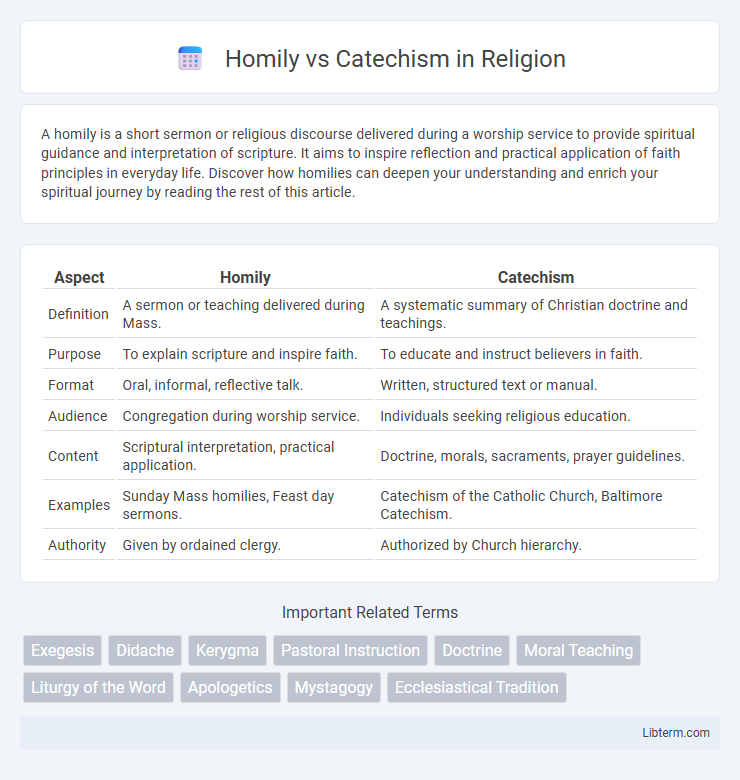A homily is a short sermon or religious discourse delivered during a worship service to provide spiritual guidance and interpretation of scripture. It aims to inspire reflection and practical application of faith principles in everyday life. Discover how homilies can deepen your understanding and enrich your spiritual journey by reading the rest of this article.
Table of Comparison
| Aspect | Homily | Catechism |
|---|---|---|
| Definition | A sermon or teaching delivered during Mass. | A systematic summary of Christian doctrine and teachings. |
| Purpose | To explain scripture and inspire faith. | To educate and instruct believers in faith. |
| Format | Oral, informal, reflective talk. | Written, structured text or manual. |
| Audience | Congregation during worship service. | Individuals seeking religious education. |
| Content | Scriptural interpretation, practical application. | Doctrine, morals, sacraments, prayer guidelines. |
| Examples | Sunday Mass homilies, Feast day sermons. | Catechism of the Catholic Church, Baltimore Catechism. |
| Authority | Given by ordained clergy. | Authorized by Church hierarchy. |
Understanding Homily: Definition and Purpose
A homily is a brief sermon or discourse delivered during a liturgical service, aimed at interpreting Scripture and applying its teachings to everyday life. It focuses on spiritual reflection and encouragement, helping the congregation deepen their faith and live according to Christian values. Unlike the catechism, which systematically presents Church doctrine, the homily emphasizes practical understanding and personal connection to biblical messages.
What is Catechism? An Overview
Catechism is a structured summary of Christian doctrine used for religious education, often in the form of questions and answers to facilitate learning. It systematically presents fundamental beliefs, moral teachings, and the sacraments, serving as a foundational tool in catechetical instruction. Unlike a homily, which is an extemporaneous sermon reflecting on scripture during worship, catechism provides comprehensible and organized instruction for deeper theological understanding.
Historical Origins of Homily and Catechism
The homily traces its origins to early Christian worship, where clergy expounded upon Scripture during the liturgy to instruct and inspire the faithful. Catechism developed as a formalized method of religious education, crystallizing in the early Church to systematically teach core doctrines through question-and-answer formats. Both have evolved to serve complementary roles in conveying Christian teachings, with the homily focusing on scriptural interpretation and the catechism emphasizing doctrinal instruction.
Key Differences Between Homily and Catechism
A homily is a sermon or reflection given during a religious service, typically based on a specific scripture passage, aiming to provide spiritual insight and practical application for the congregation. Catechism, on the other hand, is a structured summary of Christian doctrine used for teaching the fundamental beliefs and principles of the faith, often delivered through question-and-answer format. The key difference lies in the homily's focus on interpretative explanation for worshippers versus catechism's emphasis on systematic religious education and doctrinal instruction.
Role of Homily in Worship Services
The homily plays a crucial role in worship services by providing a practical and relatable explanation of scripture readings, helping congregants understand and apply biblical teachings to their daily lives. It bridges the gap between ancient texts and contemporary experiences, fostering spiritual growth and moral reflection within the faith community. Unlike the catechism, which systematically outlines doctrinal beliefs, the homily engages the congregation through narrative and reflection during liturgical celebrations.
Catechism as a Teaching Tool in Faith Formation
Catechism serves as a structured teaching tool in faith formation, providing comprehensive and systematic instruction on core doctrines, sacraments, and moral teachings of the Church. Unlike a homily, which offers reflective interpretation of Scripture tailored to the liturgical context, catechism delivers detailed explanations and answers to essential questions, fostering deeper understanding and consistent transmission of Catholic beliefs. This methodical approach equips catechumens and believers with foundational knowledge essential for informed faith practice and spiritual growth.
Homily vs Catechism: Audience and Context
A homily is a spoken reflection delivered by clergy during a religious service, aimed at engaging the congregation with practical and spiritual insights related to scripture readings. The catechism serves as a structured, instructional text outlining core doctrines and teachings of the faith, designed for systematic learning and catechetical instruction. While homilies target a diverse assembly seeking immediate spiritual application, catechisms are tailored for learners requiring comprehensive theological education and doctrinal clarity.
Impact on Spiritual Growth: Homily and Catechism
Homilies offer personalized, contextual reflections on Scripture that directly engage congregants, fostering immediate spiritual insight and emotional connection. Catechism provides a structured, comprehensive framework of faith teachings that deepens doctrinal understanding and supports sustained spiritual development over time. Together, homilies and catechism complement each other by balancing experiential inspiration with foundational knowledge, enhancing overall spiritual growth.
Contemporary Examples of Homily and Catechism
Contemporary homilies often incorporate current social issues such as climate change and social justice, engaging congregations through relatable narratives and scriptural reflections. Modern catechisms, like the YouCat, provide structured, accessible teachings on Catholic doctrine through question-and-answer formats, emphasizing clarity for youth and new members. Both aim to deepen faith understanding, with homilies fostering personal application and catechisms ensuring doctrinal consistency.
Choosing the Right Approach: Homily or Catechism
Choosing between a homily and catechism depends on the learning context and audience engagement; homilies offer reflective, scripture-based messages suitable for communal worship, while catechisms provide structured doctrinal instruction essential for foundational religious education. Homilies foster spiritual growth through personalized interpretation, whereas catechisms emphasize memorization and comprehension of core beliefs. Understanding the audience's needs and learning objectives guides the effective use of either approach in faith formation.
Homily Infographic

 libterm.com
libterm.com